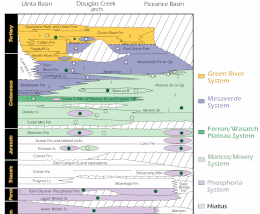Mancos Shale
| Mancos Shale | |
|---|---|
Ma | |
Dakota Group | |
| Lithology | |
| Primary | Shale |
| Location | |
| Coordinates | 37°21′11″N 108°17′49″W / 37.353°N 108.297°W |
| Region | Arizona, Colorado, New Mexico, Utah, Wyoming |
| Country | |
| Extent | Basin and Range, Colorado Plateau & San Juan Mountains Provinces |
| Type section | |
| Named for | Mancos, Colorado |
The Mancos Shale or Mancos Group is a
The Mancos Shale was first described by Cross and Purington in 1899[1] and was named for exposures near the town of Mancos, Colorado.
Geology

The unit is dominated by
The lower marine Mancos Shale conformably
Thus, the classification broadly corresponds with the Colorado Group classification of the Great Plains region. As such, various units of the Colorado Group are recognized within the Mancos in those areas where their distinct facies can be recognized.[3]
Occurrences


The Mancos occurs in the Basin and Range Province, the Colorado Plateau Province, and the San Juan Mountains Province.
Structural basins
The Mancos is a diverse unit, with dozens of named subunits in different
|
|
|
|
History of investigation
The Mancos Shale was first named by Charles Whitman Cross and C.W. Purington in 1899, for outcrops near the town of Mancos, Colorado and along the Mancos River nearby. The two geologists also traced the unit into the Telluride, Colorado area.[1] W.T. Lee had traced the unit north into the Grand Mesa area, defining it as all marine shale between the Dakota and the Mesaverde.[19] It was subsequently traced into Utah[20] and New Mexico.[21]
During their work in New Mexico in 1924, J.B. Reeside, Jr., and F.H. Knowlton found that the Mancos Shale could be divided into
See also
- List of fossiliferous stratigraphic units in Arizona
- List of fossiliferous stratigraphic units in Colorado
- List of fossiliferous stratigraphic units in New Mexico
- List of fossiliferous stratigraphic units in Utah
- List of fossiliferous stratigraphic units in Wyoming
References
- ^ a b Cross, C.W.; Purington, C. W. (1899). "Description of the Telluride quadrangle, Colorado". United States Geological Survey Atlas. Vol. 57.
- .
- ^ a b c Rankin, Charles H. (1944). "Stratigraphy of the Colorado Group, Upper Cretaceous, in Northern New Mexico" (PDF). New Mexico Bureau of Mines and Mineral Resources Bulletins (20). New Mexico School of Mines: 5. Retrieved 2018-08-13.
...that all divisions of the Colorado group (Mancos shale) as described in southern Colorado, except the Fort Hays limestone and the Apishapa shale, can be recognized in northern New Mexico.
- ^ "Colorado River Basin Stratigraphy: Mancos Shale" United States Geological Survey
- ISBN 978-0-8137-2260-3. Retrieved 16 September 2021.
- ^ Landis, E.R.; Dane, C.H. (1967). "Geologic map of the Tierra Amarilla quadrangle, Rio Arriba County, New Mexico, with description". New Mexico Bureau of Mines and Mineral Resources Geologic Map. 19. Retrieved 17 September 2021.
- ^ Lisenbee, Alvis; Maynard, Steve (May 2001). "Geologic Map of the Captain Davis Mountain Quadrangle, Santa Fe County, New Mexico" (PDF). New Mexico Bureau of Geology and Mineral Resources Open-file Digital Geologic Map. OF-GM 48. Retrieved 16 September 2021.
- doi:10.3133/b00O.
- doi:10.3133/pp332.
- ^ Johnson, S.Y.; Johnson, R.C. (1991). "Stratigraphic and time-stratigraphic cross sections of Phanerozoic rocks along line A-A', Uinta and Piceance basin area-Eagle basin, Colorado, to eastern Basin-and-Range area, Utah". U.S. Geological Survey Miscellaneous Investigations Series Map. I-2184-A. Retrieved 15 September 2021.
- ^ doi:10.3133/b1787F.
- ^ Dane, C.H. (1948). "Geology and oil possibilites of the eastern side of the San Juan basin, Rio Arriba County, New Mexico". U.S. Geological Survey Oil and Gas Investigations Map. OM-78. Retrieved 16 September 2021.
- ^ Owen, Donald E.; Forgas, Angelique M.; Miller, Shawn A.; Stelly, Ryan J.; Owen, Donald E. Jr. (2005). "Surface and subsurface stratigraphy of the Burro Canyon Formation, Dakota Sandstone, and intertongued Mancos Shale of the Chama Basin, New Mexico" (PDF). New Mexico Geological Society Field Conference Series. 56: 218–226. Retrieved 15 September 2021.
- doi:10.3133/pp521E.
- doi:10.3133/b1372J.
- ^ Hook, Steven C. (1983). "Contributions to mid-Cretaceous paleontology and stratigraphy of New Mexico — part II" (PDF). New Mexico Bureau of Mines & Mineral Resources Circular. 185: 15–16. Retrieved 17 September 2021.
- .
- doi:10.3133/b1787M.
- hdl:2346/65145.
- doi:10.3133/b541D.
- doi:10.3133/pp134.
- ^ Jamison, C.E. (1911). "Geology and Mineral Resources of a Portion of Fremont County, Wyo". Wyoming Geological Survey Bulletin. 2B. Retrieved 21 September 2021.
- ^ Zakis, William (1952). "Table Mesa Oil Field San Juan County, New Mexico". Geological Symposium of the Four Corners Region. Retrieved 21 September 2021.
- .



